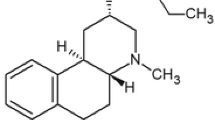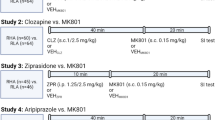Abstract
Rationale
Selective attention deficit, characterised by the inability to differentiate relevant from irrelevant information, is considered to underlie many cognitive deficits of schizophrenia, and appears to be only marginally responsive to treatment with current antipsychotics.
Objectives
We compared the activity of the putative atypical antipsychotic SSR181507 (a dopamine D2 receptor antagonist and 5HT1A receptor agonist) with reference compounds, on disturbances of novelty discrimination in a social context in rats, a behavioural paradigm that putatively models selective attention deficit.
Methods
A first (familiar) juvenile rat was presented to an adult rat for a period (P1) of 30 min. A second (novel) juvenile was then introduced at the end of P1 for a period (P2) of 5 min. The ability of the adult rat to discriminate between the two juveniles, presented at the same time, was evaluated by measuring the ratio of the time spent in interaction with the novel vs the familiar juvenile during P2.
Results
Adult rats spent more time exploring the novel than the familiar juvenile. This novelty discrimination capacity was disrupted by: (1) parametric modification of the procedure (reduction of time spent in contact with the familiar juvenile during P1); (2) acute injection of psychotomimetics that are known to induce schizophrenia-like symptoms in humans, such as phencyclidine (PCP; 3 mg/kg, i.p.) and d-amphetamine (1 mg/kg, i.p.) and (3) neonatal treatment with PCP (three injections of 10 mg/kg, s.c.), a model based on the neurodevelopmental hypothesis of schizophrenia. The potential atypical antipsychotic SSR181507 (0.03–3 mg/kg, i.p.) and the atypical antipsychotics clozapine (0.1–1 mg/kg, i.p.) and amisulpride (1–3 mg/kg, i.p.) attenuated deficits in novelty discrimination produced by parametric manipulation and by acute or neonatal treatment with PCP. The typical antipsychotic haloperidol (up to 0.3 mg/kg, i.p.) attenuated only deficits in novelty discrimination produced by parametric modification.
Conclusion
Collectively, these results suggest that SSR181507 can alleviate disturbances of novelty discrimination in a social context in rats, and that this paradigm may represent a suitable animal model of selective attention deficits observed in schizophrenia.




Similar content being viewed by others
References
Addington J, Addington MD, Gasbarre L (1996) Distractibility and symptoms in schizophrenia. J Psychiatry Neurosci 22:180–184
Al-Amin HA, Weinberger DR, Lipska BK (2000) Exaggerated MK-801-induced motor hyperactivity in rats with the neonatal lesion of the ventral hippocampus. Behav Pharmacol 11:269–278
Bakker CB, Amini FB (1961) Observations on the psychotomimetic effects of Sernyl. Compr Psychiatry 2:269–280
Barch DM, Carter CS, Hachten PC, Usher M, Cohen JD (1999) The “benefits” of distractibility: mechanism underlying increased Stroop effects in schizophrenia. Schizophr Bull 25:749–762
Black MD, Lister S, Hichcock JM, Van Giersgergen P, Soresen SM (1998) Neonatal hippocampal lesion model of schizophrenia in rats: sex differences and persistence of effects into maturity. Drug Dev Res 43:206–213
Boulay D, Depoortère R, Louis C, Perrault G, Griebel G, Soubrié P (2004) SSR181507, a putative atypical antipsychotic with dopamine D2 antagonist and 5-HT1A agonist activities: improvement of social interaction deficits induced by phencyclidine in rats. Neuropharmacology 46:1121–1129
Braff D, Stone C, Callaway E, Geyer M, Glick I, Bali L (1978) Prestimulus effects on human startle reflex in normals and schizophrenics. Psychopharmacology 15:339–343
Brébion G, Smith MJ, Gorman JM, Malaspina D, Sharif Z, Amador X (2000) Memory and schizophrenia: differential link of processing speed and selective attention with two levels of encoding. J Psychiatr Res 34:121–127
Claustre Y, De Peretti D, Brun P, Gueudet C, Allouard N, Alonso R, Lourdelet J, Oblin A, Damoiseau G, Françon D, Suaud-Chagny MF, Sevrin M, George P, Steinberg R, Schoemaker H, Soubrié P, Scatton B (2003) SSR181507, a dopamine D2 receptor antagonist and 5-HT1A receptor agonist. I: neurochemical and electrophysiological profile. Neuropsychopharmacology 28:2064–2076
Cohen JD, Servan-Schreiber D (1992) Context, cortex and dopamine: a connectionist approach to behavior and biology in schizophrenia. Psychol Rev 99:45–77
Coward DM, Imperato A, Urwyler S, White TG (1989) Biochemical and behavioural properties of clozapine. Psychopharmacology 99:6–12
Craft S, Gourovitch ML, Dowton SB, Swanson JM, Bonforte S (1992) Lateralized deficits in visual attention in males with developmental dopamine depletion. Neuropsychologia 30:341–351
Depoortere R, Boulay D, Perrault G, Bergis O, Decobert M, Françon D, Jung M, Simiand J, Soubrié P, Scatton B (2003) SSR181507, a dopamine D2 receptor antagonist and 5-HT1A receptor agonist. II. Behavioral profile predictive of an atypical antipsychotic activity. Neuropsychopharmacology 28:1889–1902
Engelmann M, Wotjak CT, Landgraf R (1995) Social discrimination procedure: an alternative method to investigate juvenile recognition abilities in rats. Physiol Behav 58:315–321
Freedman R, Olincy A, Ross RG, Waldo MC, Stevens KE, Adler LE, Leonard S (2003) The genetics of sensory gating deficits in schizophrenia. Curr Psychiatry Rep 5:155–161
Geyer MA, Swerdlow NR, Mansbach RS, Braff DL (1990) Startle response models of sensorimotor gating and habituation deficits in schizophrenia. Brain Res Bull 25:485–498
Geyer MA, Krebs-Thompson K, Braff DL, Swerdlow NR (2001) Pharmacological studies of prepulse inhibition models of sensorimotor gating in schizophrenia: a decade in review. Psychopharmacology 156:117–154
Hofer E, Doby D, Anderer P, Dantendorfer K (2001) Impaired conditional discrimination learning in schizophrenia. Schizophr Res 51:127–136
Jackson JJ, Soliman MR (1996) Effects of tacrine (THA) on spatial reference memory and cholinergic enzymes in specific rat brain regions. Life Sci 58:47–54
Jin J, Yamamoto T, Watanabe S (1997) The involvement of sigma receptors in the choice reaction performance deficits induced by phencyclidine. Eur J Pharmacol 319:147–152
Kuroki T, Meltzer HY, Ichikawa J (1999) Effects of antipsychotic drugs on extracellular dopamine levels in rat medial prefrontal cortex and nucleus accumbens. J Pharmacol Exp Ther 288:774–781
Lewis R (2004) Should cognitive deficit be a diagnostic criterion for schizophrenia? J Psychiatry Neurosci 29:102–113
Lieberman JA, Sheitman BB, Kinon BJ (1997) Neurochemical sensitization in the pathophysiology of schizophrenia: deficits and dysfunction in neuronal regulation and plasticity. Neuropsychopharmacology 17:205–229
Lipska BK, Weinberger MD (2000) To model a psychiatric disorder in animals: schizophrenia as a reality test. Neuropsychopharmacology 233:223–239
Lipska BK, Jaskiw GE, Weinberger DR (1993) Postpubertal emergence of hyperresponsiveness to stress and to amphetamine after neonatal excitotoxic hippocampal damage: a potential animal model of schizophrenia. Neuropsychopharmacology 9:67–75
Lipska BK, Chrapusta SJ, Egan MF, Weinberger DR (1995) Neonatal excitotoxic ventral hippocampal damage alters dopamine response to mild repeated stress and to chronic haloperidol. Synapse 20:125–130
Mansbach RS, Geyer MA (1989) Effects of phencyclidine and phencyclidine biologs on sensorimotor gating in the rat. Neuropsychopharmacology 2:299–308
McKetin R, SoloWij N (1999) Event-related potential indices of auditory selective attention in dependent amphetamine users. Biol Psychiatry 45:1488–1497
Meltzer HY, McGurk SR (1999) The effects of clozapine, risperidone and olanzapine on cognitive function in schizophrenia. Schizophr Bull 25:233–255
Moser PC, Hitchcock JM, Lister S, Moran PM (2000) The pharmacology of latent inhibition as an animal model of schizophrenia. Brain Res Rev 33:275–307
Mueser KT, McGurk SR (2004) Schizophrenia. Lancet 363:2063–2072
Muller TJ, Kalus P, Strik WK (2001) The neurophysiological meaning of auditory P300 in subtypes of schizophrenia. World J Biol Psychiatry 2:9–17
Oranje B, Van Berckel BN, Kemner C, Van Ree JM, Kahn RS, Verbaten MN (2000) The effects of a sub-anaesthetic dose of ketamine on human selective attention. Neuropsychopharmacology 22:293–302
Perio A, Terranova JP, Worms P, Bluthe RM, Dantzer R, Biziere K (1989) Specific modulation of social memory in rats by cholinomimetic and nootropic drugs, by benzodiazepine inverse agonists, but not by psychostimulants. Psychopharmacology 97:262–268
Perrault G, Depoortere R, Morel E, Sanger DJ, Scatton B (1997) Psychopharmacological profile of amisulpride: an antipsychotic drug with presynaptic D2/D3 dopamine receptor antagonist activity and limbic selectivity. J Pharmacol Exp Ther 280:73–82
Pinelli P, Ceriani F, Colombo R, Pasetti C, Terazzi M, Castignoli G (2000) Delayed verbal reactions are specifically impaired in patients with schizophrenia. Int J Psychol 37:163–175
Robbins TW (2002) The 5-choice serial reaction time task: behavioural pharmacology and functional neurochemistry. Psychopharmacology 165:362–380
Russig H, Kovacevic A, Murphy CA, Feldon J (2003) Haloperidol and clozapine antagonise amphetamine-induced disruption of latent inhibition of conditioned taste aversion. Psychopharmacology 170:263–270
Salo R, Nordahl TE, Possin K, Leamon M, Gibson DR, Galloway GP, Flynn NM, Henik A, Pfefferbaum A, Sullivan EV (2002) Preliminary evidence of reduced cognitive inhibition in methamphetamine-dependent individuals. Psychiatry Res 111:65–74
Schoemaker H, Claustre Y, Fage D, Rouquier L, Chergui K, Curet O, Oblin A, Gonon F, Carter C, Benavides J, Scatton B (1997) Neurochemical characteristics of amisulpride, an atypical dopamine D2/D3 receptor antagonist with both presynaptic and limbic selectivity. J Pharmacol Exp Ther 280:83–97
Servan-Schreiber D, Bruno RM, Carter CS, Cohen JD (1998) Dopamine and the mechanisms of cognition. Part I. A neural network model predicting dopamine effects on selective attention. Biol Psychiatry 43:713–722
Sharma T (1999) Cognitive effects of conventional and atypical antipsychotics in schizophrenia. Br J Psychiatry 38:44–51
Silverstein SM (1997) Information processing, social cognition, and psychiatric rehabilitation in schizophrenia. Psychiatry 60:327–340
Stemmelin J, Cassel JC, Will B, Kelche C (1999) Sensitivity to cholinergic drug treatment of aged rats with variable degrees of spatial memory impairment. Behav Brain Res 98:53–66
Swerdlow NR, Braff DL, Geyer MA (2000) Animals models of deficient sensorimotor gating: what we know, what we think we know, and what we hope to know soon. Behav Pharmacol 11:185–204
Turgeon SM, Auerbach EA, Heller MA (1998) The delayed effects of phencyclidine (PCP) disrupt latent inhibition in a conditioned taste aversion paradigm. Pharmacol Biochem Behav 60:553–558
Wang T, Tang XC (1998) Reversal of scopolamine-induced deficits in radial maze performance by (−)-huperzine A: a comparison with E2020 and tacrine. Eur J Pharmacol 349:137–142
Wang C, Mcinnis J, Ross-Sanchez M, Shinnick-Gallagher P, Wiley JL, Johnson KM (2001) Long-term behavioural and neurodegenerative effects of perinatal phencyclidine administration: implications for schizophrenia. Neuroscience 107:535–550
Wang C, McInnis J, West JB, Bao J, Anastasio N, Guidry JA, Ye Y, Salvemini D, Johnson KM (2003) Blockade of phencyclidine-induced cortical apoptosis and deficits in prepulse inhibition by M40403, a superoxide dismutase mimetic. J Pharmacol Exp Ther 304:266–272
Weiner I (2003) The “two-headed” latent inhibition model of schizophrenia: modelling positive and negative symptoms and their treatment. Psychopharmacology 169:257–297
Weiner I, Shadach E, Tarrasch R, Kidron R, Feldon J (1996) The latent inhibition model of schizophrenia: further validation using the atypical neuroleptic, clozapine. Biol Psychiatry 40:834–843
Acknowledgements
We express our gratitude to Jean-Charles Blanchard for helpful comments on an earlier version of the manuscript, to John Alexander for his help with the English language, and to Ruth Le-Gue for technical assistance.
Author information
Authors and Affiliations
Corresponding author
Rights and permissions
About this article
Cite this article
Terranova, JP., Chabot, C., Barnouin, MC. et al. SSR181507, a dopamine D2 receptor antagonist and 5-HT1A receptor agonist, alleviates disturbances of novelty discrimination in a social context in rats, a putative model of selective attention deficit. Psychopharmacology 181, 134–144 (2005). https://doi.org/10.1007/s00213-005-2268-5
Received:
Accepted:
Published:
Issue Date:
DOI: https://doi.org/10.1007/s00213-005-2268-5




